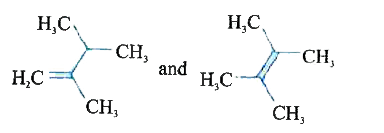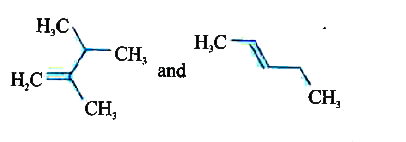An alkyl halide (X)of the folmula C6H13Cl on treatment with potassium tertiary butoxide gives two isomeric alkenes (Y) and (Z)(C6H12). Both the alkenes on hydrogenation give 2,3−dimethyl butane. Perdict the structures of (X),(Y) , and (Z)
It is given that
C6H13Cl(X)(CH3)3CO−K−−−−−−−−−−−→Two isomeric alkenes of formulaC6H12(Y) and (Z)H2−−→CH3−CH3∣CH−CH3∣CH−CH32, 3-Dimethylbutane
The two alkenes forming 2, 3-dimethyl butane are:
CH3−CH3∣C=CH3∣C−CH3(Y) and CH2=CH3∣C−CH3∣CH−CH3(Z)
Topper's Solved these Questions
- HALOALKANES AND HALOARENESBOOK - MODERN PUBLICATIONCHAPTER - HALOALKANES AND HALOARENESEXERCISE - A. MULTIPLE CHOICE QUESTIONS (with only one correct answer)
35 Videos
- HALOALKANES AND HALOARENESBOOK - MODERN PUBLICATIONCHAPTER - HALOALKANES AND HALOARENESEXERCISE - B. MULTIPLE CHOICE QUESTIONS (from competitive Examinations)
63 Videos
- HALOALKANES AND HALOARENESBOOK - MODERN PUBLICATIONCHAPTER - HALOALKANES AND HALOARENESEXERCISE - REVISION EXERCISE (Long Answer Questions)
4 Videos
- GENERAL PRINCIPLES AND PROCESSES OF ISOLATION OF ELEMENTSBOOK - MODERN PUBLICATIONCHAPTER - GENERAL PRINCIPLES AND PROCESSES OF ISOLATION OF ELEMENTSEXERCISE - COMPETION FILE (Integer Type Numerical Value Type Questions)
5 Videos
- ORGANIC COMPOUNDS CONTAINING NITROGEN BOOK - MODERN PUBLICATIONCHAPTER - ORGANIC COMPOUNDS CONTAINING NITROGEN EXERCISE - UNIT PRACTICE TEST
5 Videos
Similar Questions
An alkyl halide (X)of the folmula C6H13Cl on treatment with potassium tertiary butoxide gives two isomeric alkenes (Y) and (Z)(C6H12). Both the alkenes on hydrogenation give 2,3−dimethyl butane. Perdict the structures of (X),(Y) , and (Z)
View SolutionAn alkyl halide (A) of formula C6H11Cl on treatment with potassium tertiary butoxide gives two isomeric alkenes (B) and (C) C6H10. Both alkene on hydrogenation give methylcyclopentane. Predict the structure of (A), (B) and (C).
View Solution
Knowledge Check
An alkyl halide of formula C6CH13Cl on treatment with potassium t-butoxide gives two isomeric alkenes (C6H12). Both alkenes on hydrogenation give 2,2-dimethylbutane. Isomeric alkenes are
ACH2=C∣CH3−C∣CH3H−CH3andCH3−C∣CH2=C∣CH3−CH3BCH2=C∣CH3−C∣CH3H−CH3andCH3−CH=CH−CH2CH3CCH3−CH=CH−CH2CH3and(CH3)2C=(CH3)2DCH2=C∣CH3−C∣CH3H−CH3andCH2=C∣CH3−CH2−CH2−CH3An alkyl halide of formula C6H13CI on treatment with potassium t-butoxide given two isomeric alkanes (C6H12) . Both alkenes on hydrogenation give 2,3 dimethyl butane. Isomeric alkanes are
A B
B C
C D
D
An alkyl halide of formula C6H13Br on treatment with potassium t-butoxide gives two isomeric alkenes dimethy butane. Isomeric alkene are :
A B
B C
C D
D
An aromatic kentone (X) has the molecular formula C10H12O2. On vigorous oxidation, it yields a dibasic acid (Y) having the formula C9H8O5 which rapidly forms an anhydride on heating. (X) on strong heating with sodium hypobromite gives monobasic acid (Z) with the formula C9H10O3. (Z), when heated with soda lime, gives 3-methylanisole. Interpret the above reactions and deduce the structures of (X), (Y), and (Z).
View SolutionAn alkyl halide of formula C4H9Cl on treatement with alcoholic potash gives alkenes C4H8. Both alkenes on tratment with HI gives 2-iodo butate. Isomeric alkenes are
View SolutionAn alkyl halide of formula C4H9Cl on treatment with alcoholic potash gives alkenes C4H8. Both alkenes on treatment with HI give 2-iodobutane. Isomeric alkenes are
View SolutionAn alkene (C6H12) is optically active.This on reductive oxonolysis gives
View SolutionNo. of structural isoneric alkenes (molecular formula =C6H12) which all give n-hexane on hydrogenation in presence of metal catalyst
View Solution
